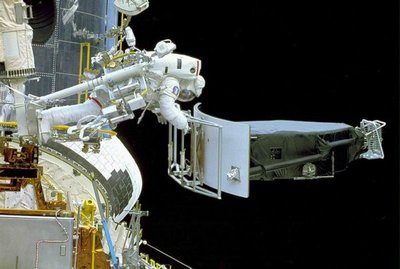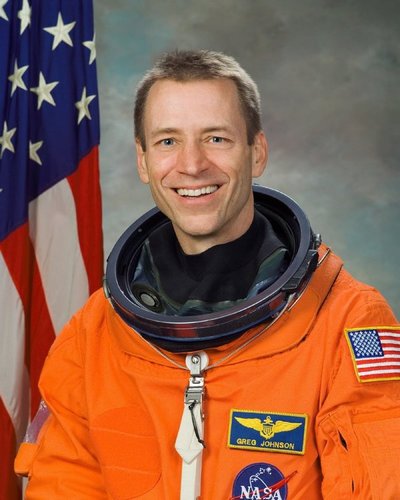May 6, 2009
UW will be prominent in space shuttle mission to service Hubble telescope
When the space shuttle Atlantis blasts off from Cape Canaveral, Fla., on May 11, the University of Washington will be front and center in the final mission to service and repair the Hubble Space Telescope.
Atlantis will be piloted by UW engineering graduate Gregory C. Johnson and will carry a new Hubble camera that a team of scientists that includes Bruce Balick, a UW astronomy professor, has been working on for 10 years.
Johnson will carry a banner for the UW’s aeronautics and astronautics department. He was born in Seattle, attended West Seattle High School and graduated from the UW in 1977 with a bachelor’s degree in aeronautical and astronautical engineering.
Adam Bruckner, chair of the UW aeronautics and astronautics department, remembers Johnson as a bright, attentive student who sat in the front row during the laboratory classes he taught in 1976. Johnson is one of 15 NASA astronauts who have ties to the university.
UW astronomers also helped develop one of two new instruments to be delivered during this mission. The Wide Field Camera 3 will replace the Wide Field Planetary Camera 2, which was installed on Hubble during a servicing mission in 1994. That camera, which has produced most of the stirring images most associated with the orbiting telescope, replaced the original wide field camera that was on Hubble when it was launched in April 1990.
Balick, a former UW astronomy chairman, is a member of the Scientific Oversight Committee designed to represent the entire international astronomy community in defining the mission for the new camera and make sure it operates effectively, as well as making design and budget decisions. Hubble has played a major role in his research since 1995.
The new camera used many of the parts of the first camera, Balick said, but its capabilities will be far greater than either of its predecessors. Those cameras could only record observations in red and green wavelengths, but the new camera has been designed to work effectively in the infrared, blue, violet and ultraviolet parts of the spectrum as well. He expects the new images to provide even greater detail of how the universe works.
Hubble’s famed images are 100 times sharper than those from telescopes on the ground, though because of its magnification it can only observe a patch of sky the size of 1 percent of a full moon. It also can observe the universe in wavelengths such as ultraviolet that do not penetrate the Earth’s atmosphere.
“We can see the haystacks from the ground. We need a telescope like Hubble to study the needles,” Balick said. “That’s where the research frontiers of astronomy are, especially for studies of tiny galaxies at the edge of the visible universe.”
The new camera will make it possible to study the formation of hot massive stars that explode as supernovae at the end of their lives, and to explore how such stars evolve and interact with the clouds of dust and gas that they form. The new camera can probe the earliest stages of star and planet formation, and is the only way for scientists to find out how stars like ours form, evolve and die.
Similarly, astronomers will be able to use the new camera’s infrared capabilities to study how galaxies form and to examine the most remote parts of the universe, which send light to us from the very first generation of stars that formed after the big bang.
“In other words, we can peer into our earliest history, at least in a statistical sense. I’d like to see a historian or a geologist try that,” Balick said.
“We defined a number of key astronomical questions that we want answered, and we designed the camera to answer them. But when the history books are written I know the value of the camera will be something different from what we expected,” Balick said.
In his own work, he hopes to use the camera to study how aging stars blow off their outer layers before they die. As that happens, they inject carbon into the gas and dust that fills the void between stars in a galaxy, and the carbon can lead to the formation of life.
Hubble, a joint project of NASA, the European Space Agency and the Space Telescope Science Institute, can lay claim to both scientific achievement and public acclaim. During the final servicing mission, astronauts will make five spacewalks to install two new instruments, repair two inactive ones, and replace equipment such as batteries and gyroscopes to keep the telescope operational at least into 2014. When it is no longer functional, Hubble will be sent into the Pacific Ocean.
Previous service trips during the Hubble’s 19-year operation took place in 1993, 1997, 1999 and 2002. This will be the fifth and final mission to the Hubble.
“No matter how you measure it, the Hubble is the biggest bang for the buck any space mission has given to date,” Bruckner said. “The amount of information it has recorded and the number of discoveries it has generated are incomparable.”
###
For more information, contact Balick at 206-543-7683 or balick@astro.washington.edu and Bruckner at 206-543-6143 or bruckner@aa.washington.edu


